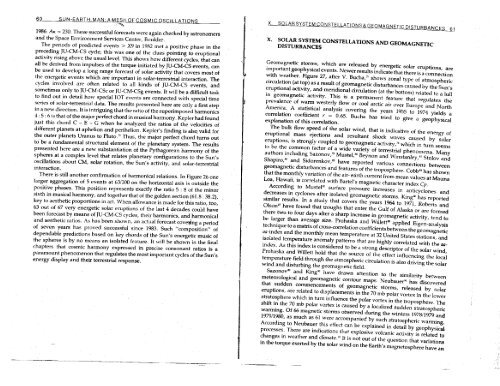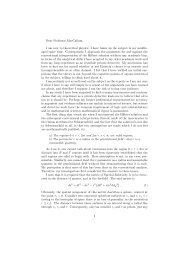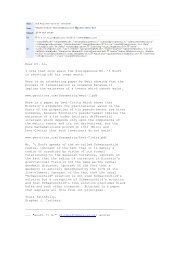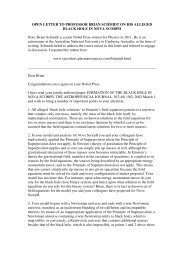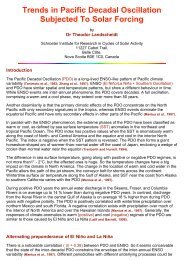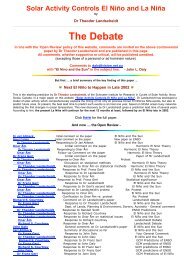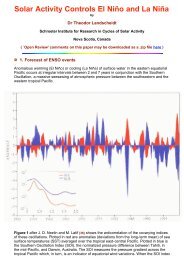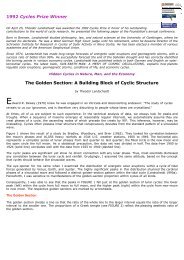Sun-Earth-Man - PlasmaResources
Sun-Earth-Man - PlasmaResources
Sun-Earth-Man - PlasmaResources
Create successful ePaper yourself
Turn your PDF publications into a flip-book with our unique Google optimized e-Paper software.
1986: AK = 230. These successful forecasts were againchecked by astronomers<br />
and the Space Environment Services Center, Boulder.<br />
The periods of predicted ev?nts > X9 in 1982 met a positive phase in the<br />
preceding JU-CM-CS cycle; this was one of the clues pointing to emptional<br />
activity rising above the usual level. This shows how different cycles, that can<br />
all be derived from impulses of the torque initiated by JU-CM-CS events, can<br />
be used to develop a Iong range forecast of solar activity that covers most of<br />
the energetic events which are important in solar-terrestrial interaction. The<br />
cycles involved are often related to all kinds of JU-CM-CS events, and<br />
sometimes only to JU-CM-CSc or JU-CM-CSg events. It will be a difficult task<br />
to find out in detail how special IOT events are connected with special time<br />
series of solar-terrestrial data. The results presented here are only a first step<br />
in a new direction. It is intriguing that the ratio of the superimposed harmonics<br />
4 : 5 : 6 is that of the major perfect chord in musical harmony. Kepler had found<br />
just this chord C - E - G when he analyzed the ratios of the velocities of<br />
different planets at aphelion and perihelion. Kepler's finding is also.valid for<br />
the outer planets Uranus to Pl~to.~"hus, the major perfect chord turns out<br />
to be a iundamental structural element of the planetary system. The results<br />
presented here are a new substantiation of the Pythagorean harmony of the<br />
spheres at a complex level that relates planetary configurations to the <strong>Sun</strong>'s<br />
oscillations about CM, solar rotation, the <strong>Sun</strong>'s activity, and solar-terrestrial<br />
interaction.<br />
There is still another confirmation of harmonical relations. In Figure 26 one<br />
larger aggregation of 5 events at 631100 on the horizontal axis is outside the<br />
positive phases. This position represents exactly the ratio 5 : 8 of the minor<br />
sixth in musical harmony, and together that of the golden section (61.8 : 38.2),<br />
key to aesthetic proportions in art. When allowance is made for this ratio, too,<br />
63 out of 67 very energetic solar eruptions of the last 4 decades could have<br />
been forecast by means of JU-CM-CS cycles, their harmonics, and harmonica1<br />
and aesthetic ratios. As has been shown, an actual forecast covedng a period<br />
of seven years has proved successful since 1983. Such "composition" of<br />
dependable predictions based on key chords of the <strong>Sun</strong>'s energetic music of<br />
the spheres is by no means an isolated feature. It will be shown in the final<br />
chapters that cosmic harmony expressed in precise consonant ratios is a<br />
paramount phenomenon that regulates the most important cycles of the <strong>Sun</strong>'s<br />
energy display and their terrestrial response.<br />
X. SOLAR SYSTEM CONSTELLATIONS & GEOMAGNETIC DISTURBANCES 61<br />
X. SOLAR SYSTEM CONSTELLATIONS AND GEOMAGNETIC<br />
DISTURBANCES<br />
Geomagnetic storms, which are released by energetic solar eruptions, are<br />
important geophysical events. Newer results indicate that there IS a connection<br />
with weather. Figure 27, after V. B~cha,~ shows zonal type of atmospheric<br />
circulation (at top) as a result of geomagnetic disturbances caused by the <strong>Sun</strong>'s<br />
eruptional activity, and meridional circulation (at the bottom) related to a lull<br />
in geomagnetic achvity. This is a permanent feature that regulates the<br />
prevalence of warm westerly flow or cool arctic air over Europe and North<br />
Arnerlca. A statistical analysis covering the years 1955 to 1974 yields a<br />
correlation coefficient r = 0.65. Bucha has tned to give a geophysicaI<br />
explanation of this correlation.<br />
The bulk flow speed of the solar wind, that is indicative of the energy of<br />
eruptional mass ejections and resultant shock waves caused bv solar<br />
eruptions, is strongly coupled to geomagnetic activity," which in turn seems<br />
to be the common factor of a wide variety of terrestrial phenomena. <strong>Man</strong>y<br />
authors including Sazono~,~ MustelPM Beynon and Win~tanley,~~ Stolov and<br />
Shapir~,~' and Sidorenkov," have reported various connections between<br />
geomagnetic disturbances and features of the troposphere. CobbN has shown<br />
that the monthly variation of the air- earth current from mean values at Mauna<br />
Loa, Hawaii, is correlated with Barters magnetic character index Cp.<br />
According to Mustelas surface pressure increases in anticyclones and<br />
decreases in cydones after isolated geomagnetic storms. %ngB" has reported<br />
similar results. In a study that covers the years 1964 to 1971, Roberts and<br />
Otsonw have found that troughs that enter the Gulf of Alaska or are formed<br />
there two to four days after a sharp increase in geomagnetic activity, tend to<br />
be larger than average size. Prohaska and WilletteB applied Eigen-analysis<br />
technique to a matrix of cross-correlatinn coefficients between the geomagnetic<br />
aa-index and the monthly mean temperature at 32 United States stations, and<br />
isoIated temperature anomaly patterns that are highly correlated with the aaindex.<br />
As this index is considered to be a strong descriptor of the solar wind,<br />
Prohaska and WilIett hold that the source of the effect influencing the local<br />
temperature field through the atmospheric circulation is also driving the solar<br />
wind and disturbing the geomagnetic field.<br />
Sazonov" and Kingm have drawn attention to the similarity between<br />
meteorologicaI and geomagnetic contour maps. Neubauer" has discovered<br />
that sudden commencements of geomagnetic storms, released by solar<br />
eruptions, are related to displacements in the 70 mb polar vortex in the Lower<br />
stratosphere which in turn influence the polar vortex in the troposphere. The<br />
shift in the 70 mb poIar vortex is caused by a localized sudden stratospheric<br />
warming. Of 66 magnetic stonns observed during the winters 197811979 and<br />
197411980, as much as 61 were accompanied by such stratospheric warming,<br />
According to Neubauer this effect can be explained in detail by geophysical<br />
processes. There are indications that explosive volcanic activity is related to<br />
changes in weather and It is not out of the question that variations<br />
in the torque exerted by the solar wind on the <strong>Earth</strong>'s magnetosphere have an


